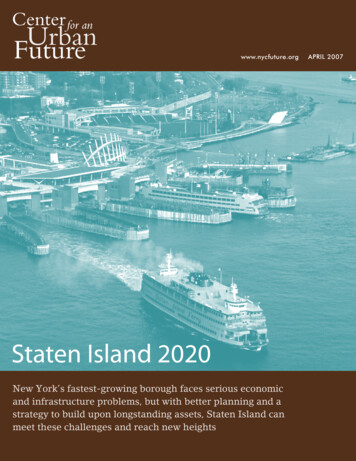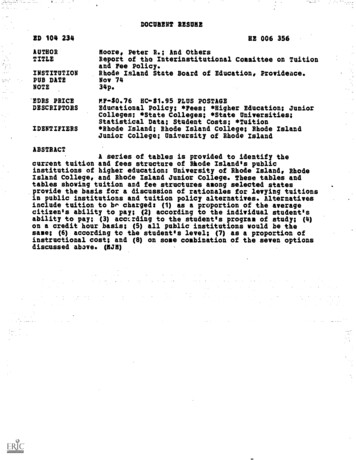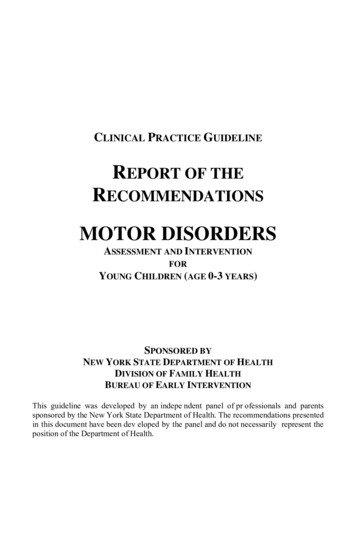
Transcription
www.nycfuture.orgStaten Island 2020New York’s fastest-growing borough faces serious economicand infrastructure problems, but with better planning and astrategy to build upon longstanding assets, Staten Island canmeet these challenges and reach new heightsAPRIL 2007
CONTENTSThis report was written by Jonathan Bowlesand Jim O’Grady of the Center for an UrbanFuture. Research assistance was provided byTara Colton, Keenan Hughes, Nick Judd, Lindsey Ganson and Nancy Campbell.The Center for an Urban Future is a New YorkCity-based think tank dedicated to independent, fact-based research about critical issuesaffecting New York’s future including economic development, workforce develoment, highereducation and the arts. For more informationor to sign up for our monthly e-mail bulletin,visit www.nycfuture.org.This report was funded by the Staten IslandEconomic Development Corporation. Generaloperating support has been provided by Bernard F. and Alva B. Gimbel Foundation, BoothFerris Foundation, Deutsche Bank, The F.B.Heron Foundation, The M&T Charitable Foundation, The Rockefeller Foundation, Rockefeller Philanthropy Advisors, The Scherman Foundation, Inc., and Unitarian Universalist VeatchProgram at Shelter Rock.The Center for an Urban Future is a project of City Futures, Inc. City Futures Boardof Directors: Andrew Reicher (Chair), Russell Dubner, Ken Emerson, Mark WinstonGriffith, Marc Jahr, David Lebenstein, GailMellow, Lisette Nieves, Ira Rubenstein, JohnSiegal, Karen Trella and Peter Williams.Cover photo: Michael FalcoINTRODUCTION3MOUNTING PROBLEMSRising housing prices, long commutes and an exodus ofyoung people are just some of the challenges Staten Islandmust confront in the years ahead5STATEN ISLAND IN 2020Without a change in direction, the borough could experience an economic decline and a significant deteriorationin its quality of life8OPPORTUNITIES FOR GROWTHFrom making St. George a more vital downtown to growing the maritime industry, Staten Island has a number ofachievable opportunities to strengthen its economy andcreate a more sustainable borough9PRINCIPLES FOR GROWTH15RECOMMENDATIONS16APPENDIX 1Growing and Declining Industries on Staten Island,2000-200520APPENDIX 2Excerpt From a Focus Group with Staten Island Artists21APPENDIX 3Interviews conducted for SI 2020 study22
STATEN ISLAND 2020New York’s fastest-growing borough faces serious economic andinfrastructure problems, but with better planning and a strategyto build upon longstanding assets, Staten Island can meet thesechallenges and reach new heightsSTATEN ISLAND HAS MUCH AT STAKE BETWEEN NOW AND 2020.On the one hand, Staten Island is on the brink of reaching new heights. It is home toseveral of the city’s most attractive neighborhoods, enjoys a high overall quality oflife and has an array of somewhat hidden jewels like the St. George Theatre, Midland and South Beaches and Wagner College. The number of jobs in the boroughhas been on the rise, some long-depressed neighborhoods are poised for a renaissance and Staten Island has ample opportunities to grow and diversify its economyin the years ahead.At the same time, Staten Island faces profound economic and infrastructure challenges—from an alarming exodus of young people and rising commuting times tostubbornly high vacancy rates in the borough’s office buildings and mounting frustration among business owners, urban planners and developers that Staten Islandis an impossible place to get anything done. Additionally, while employment numbers are up, most of the industries that are currently growing pay very low wages, atrend that’s likely to persist if the retail and health services sectors continue to drivemuch of the borough’s growth. All of these problems will be playing out amidst anear certain spike in the population in the decades ahead: the borough is expectedto add another 77,000 people over the next 25 years.1By 2020, if left unaddressed, these problems will almost certainly overwhelm theborough, cause it to miss out on golden opportunities for sustainable growth andundermine much of what has long made Staten Island attractive as a place to liveand work.
4As this report makes clear, 2020 could be a year oftriumph for Staten Island. By then, the borough’s NorthShore waterfront should be a national showcase, insteadof an embarrassment; a new, more functional GoethalsBridge will be well on its way; St. George and Stapletoncould be mentioned in the same breath as Hoboken andLong Branch as models of transit-oriented development;and the West Shore could be the site of hundreds of newjobs as well as a modern light rail system that, ideally,would link to the PATH train and Manhattan by way ofthe Bergen-Hudson Light Rail Line.The latter half of this report includes several suggested principles for growth and a long menu of possible recommendations for the Staten Island EconomicDevelopment Corporation (SIEDC) and other leaders inthe borough to carry out, several of which are achievable in the immediate future. But the three things mostcommonly heard among the Staten Islanders we interviewed were quite basic: 1) engage in better planning forthe borough’s growth; 2) the borough’s business, government and civic officials need to pay much closer attentionto the borough’s economic challenges and demonstratebetter leadership; and 3) figure out what Staten Islandwants to be when it grows up—a bedroom community oran independent economic entity.We agree with all three sentiments.The lack of planning is a big part of why Staten Island faces so many fundamental challenges today. Andthoughtful planning is undoubtedly critical to the borough’s future. Only by engaging in sensible planningcan the borough accommodate the expected populationgrowth in a way that doesn’t overtax the infrastructure,undermine the borough’s existing assets or leave the island with a significantly higher unemployment rate.Meanwhile, there have been stunning gaps in leadership on issues affecting the borough’s economic future.“There’s no shortage of good ideas for Staten Island,”says one economic development expert. “But there is adramatic lack of leadership.” Indeed, well over a dozenof the Staten Islanders interviewed for this report mentioned that the borough’s politicians repeatedly fail toput the island’s greater good over narrow, parochial concerns. Unfortunately, Staten Island’s business, civic andcommunity leaders haven’t exactly picked up the slack.In several cases, divisions among the borough’s majorcivic and community institutions have only magnified theleadership vacuum.The question about Staten Island’s identity is alsoworthy of careful debate and discussion. We believe thatStaten Island is largely a bedroom community, and thatall future planning and development efforts should keepin mind the importance of maintaining an attractive environment for families and understand that many neighborhoods across the borough must never lose the quiet,suburban charms that have long attracted residents looking for a very different pace of life than Manhattan orBrooklyn.At the same time, we believe that Staten Island isa bedroom community that has always had—and shouldcontinue to have—a strong and diverse local economy.After all, more Staten Islanders go to work in their ownborough (86,197) than commute to Manhattan and Brooklyn combined (82,674).2 These are important jobs for acommunity that now has nearly half a million residentsand, given the long work commute that many Staten Islanders have to endure, the prospect of more on-islandwork opportunities should be welcome.The trick is to hang onto all of the traits that makethe borough an attractive bedroom community while notlosing sight of the need to bolster and diversify the localjob base. In the pages that follow, we attempt to chart acourse toward achieving this balancing act.Background and MethodologyIn September 2006, SIEDC commissioned the Center for an Urban Future to undertake an independentstudy that “provides a critical analysis of the currentstate of the Staten Island economy and presents a series of specific actions and policy recommendationsthat will guide Staten Island’s business and civic leaders towards the creation of a diverse economy that offers a range of employment opportunities.”Over the next five months, the Center for an Urban Future examined volumes of data and conductedinterviews with more than 125 stakeholders and policy experts to get a handle on where Staten Island’seconomy is heading, what the major challenges areand where there may be opportunities for growth inthe years ahead. The vast majority of the interviewswere conducted with Staten Island-based stakeholders—from major business leaders and developers toentrepreneurs, university officials, leaders of culturalinstitutions, transportation experts, community leaders,workforce development experts and government officials. We held a focus group with several artists whoare living on Staten Island. We also conducted severalinterviews with policy experts and government officialslocated off the island, including some of New York’stop economic development experts and waterfrontplanners, as well as a number of New Jersey-basedplanners and municipal officials. (A list of those interviewed is found in Appendix 3 on page 22).
5Mounting ProblemsRising housing prices, long commutes and an exodus of young people are just some of thechallenges Staten Island must confront in the years aheadAn increasing number of Staten Islanders are givingup on the borough and moving elsewhere. Staten Island has long had positive domestic migrationtrends, meaning that more native-born households weremoving into the borough than leaving the borough. Butthat has reversed itself in the past three years. In 20042005, the most recent year for which figures are available from the federal government, Staten Island experienced a net out-migration of 1,188 households.3 The number of Staten Islanders leaving for NewJersey has jumped sharply in recent years. There was a34 percent increase in the number of Staten Islandersmoving to Hudson County between 1999-2000 and 20042005; a 26 percent increase in those moving to OceanCounty and a 22 percent increase in those moving toMiddlesex County.4 Staten Island continues to attract new residents fromBrooklyn, a pattern that has held true for decades. Butin the past five years, there was actually a 25 percentincrease in the number of Staten Islanders moving toBrooklyn.5 “I’m the only person from my neighborhood who stilllives on Staten Island,” said Assemblyman and lifelong Islander Michael J. Cusick in an interview for thisreport. “They’ve all moved to New Jersey. It’s easierto commute from Middletown, New Jersey to Manhattan than from Staten Island by ferry and subway ride.Staten Island used to be a destination but now it’s alanding pad. Young families land here for a little whilefrom Brooklyn and Queens, then move to New Jersey.Even though there’s high property taxes over there,young couples say the schools are better and there areone-family houses spread out, not cookie cutter houseslike here. Plus, New Jersey is economically dynamic.”Young adults between 18 and 34 appear to be fleeing theborough, a major problem since young single peopleand families add vitality and vibrancy to communities. Staten Island’s population grew by 64,751 during the1990s (a 17 percent increase), yet the number of peoplebetween the age of 18 and 34 declined by more than 5,375(a 5 percent drop) during the same period.6 Staten Islanders between 18 and 34 now account forjust 22.6 percent of the borough’s population, down from27.9 percent in 1990 and 28.32 percent in 1980.7 “Young people aren’t staying on Staten Island. Theycan’t afford homes. They don’t want to spend three hoursa day commuting to work.” “I think we’re seeing a flight of young people becausethere aren’t the jobs or interesting neighborhoods ornightlife. There’s nothing to keep the younger generation in the borough.” “I’m afraid we’re going to lose the vitality of thoseyounger people. If they’re moving out in mid-30s and40s, they’re going to be moving out just when they’remost successful.” A growing number of cities across the country andthroughout the world have developed economic develop-NET MIGRATION FOR RICHMOND COUNTY, 1999-2005400# of 02001-20022002-20032003-20042004-2005Source: Internal Revenue Service
6ment strategies around attracting young, college-educated people. Staten Island has no urban downtown and a dearth ofthe kind of affordable rental units with convenient access to Manhattan that young professionals look for. Late night ferry service has increased slightly in recentyears but it is still sparse at times when club-goers toManhattan return home from a night out. The absenceof better late-night ferry service remains a deterrent tomany young creative people moving to (or remaining in)the borough.Anecdotal evidence suggests that middle-class seniors are also leaving the borough. “Older people are leaving. There’s no senior housing onStaten Island. A lot of people I know have moved to NewJersey or Pennsylvania. They have senior communities.We don’t have anything like that. We only have nursinghomes or assisted living facilities.” “[Older people] are going to New Jersey right and left.People really want to stay, but they don’t want a nursinghome if they don’t need it.” “People who are looking for senior housing communities are leaving the island. There’s really none of this onStaten Island. That’s why people are going to New Jersey, where there are huge retirement communities. Theupper income folks can choose. There’s nothing for thefolks in the middle who don’t qualify for subsidized housing but want to stay on Staten Island.”The cost of single-family homes on Staten Island isnow out-of-reach for many middle-class families. The median sale price for single-family homes on Staten Island increased from 211,500 in 2000 to 425,000 in2006, a 101 percent increase.8 The number of Staten Islanders forced into foreclosureincreased by 47 percent in 2006, a significantly higherincrease than any other borough. Foreclosures rose by25 percent in Brooklyn, 25 percent in the Bronx and 4percent in Manhattan. The number of foreclosures inQueens declined by 8 percent.9Commuting times have been getting higher. Travel-to-work times increased from a mean time of26.2 minutes in 1980 to 39 minutes in 1990 to 43.9 minutes in 2000.10 The continued movement of financial services firmsfrom lower Manhattan to Midtown may mean that thecommute won’t be getting any shorter for some time.No financial services firms or other corporate officetenants are coming to Staten Island, despite largeamounts of vacant space and inexpensive commercialreal estate prices compared to Manhattan. The Teleport is largely vacant and has only a few dozenjobs. One of the buildings in the Corporate Park of StatenIsland has a 40 percent vacancy rate. “Companies aren’tmoving here,” says the owner of the property. “I’ve neverseen it as bad as this.” The vacancy rate in St. George office buildings is 16percent, but many of the current tenants are governmentagencies and nonprofits.11 In the months after the terrorist attacks of September11, 2001, several Manhattan-based investment banks andother corporations relocated part of their operations toNew Jersey, Brooklyn, Westchester and Connecticut. Nomajor office tenant moved to Staten Island, despite significant efforts by local business leaders and politiciansto court these Manhattan firms.GROWTH IN YOUNG PEOPLE (AGES 18-34) ON STATEN ISLAND VS.GROWTH OF THE BOROUGH'S OVERALL POPULATION, 1980-2000Population 18-341980Total 00300,000350,000400,000450,000500,000# of PeopleSource: Bureau of the Census, U.S. Department of Commerce
7MEDIAN SALES PRICE, EXISTING SINGLE-FAMILY HOMES, 2000-2006 500,000 450,000 400,000Price 350,000 300,000 250,000 200,000 150,000 100,000 50,000200020012002200320042005Nov 2006Source: New York State Association of Realtors SIEDC ran ads for the Corporate Park for roughly twoyears in Crain’s New York Business, but it didn’t generatenew tenants.12 Several of the financial services firms that opened offices at the Corporate Park around 2000 have since leftStaten Island, including American Express, MorganStanley, Prudential and Charles Schwab. The companies that remain (Merrill Lynch and Salomon Brothers) have relatively few employees on Staten Island.13Staten Island has not been able to accommodate anumber of manufacturing companies that would liketo grow there. Several manufacturers from other parts of the New YorkCity region have expressed interest in relocating to StatenIsland, but most, if not all, of these firms have ended upmoving to New Jersey or other locales in the region due toa lack of available industrial properties.14 One of the borough’s largest manufacturers will probably move off Staten Island soon because there are noexisting facilities large enough to accommodate its growthand the cost of building new space is significantly cheaperin New Jersey, even with city tax incentives.Most of the recent job growth on Staten Island hasbeen in industries that pay low wages. The industries that produced the largest net job gainsbetween 2000 and 2005 were15: Social assistance – 731 jobs (average annual wage of 21,723) Food services & drinking places – 601 jobs ( 14,417) Credit intermediation – 517 jobs ( 40,496) Grocery stores – 504 jobs ( 20,490) Professional, scientific and technical – 400 jobs( 38,305) Health & personal care stores – 392 jobs ( 21,132)One of Staten Island’s strengths is that it’s a boroughwith attractive neighborhoods. But many of theseneighborhoods have been marred in recent years bygraceless development. Developers have often crammed as many poorly designed units built of cheap materials as could fit onto alot, often next to beautiful old homes that made them lookworse by comparison. Staten Island is not the only borough that has sufferedfrom knockdowns: the tear-down of large old homes onroomy lots to build multiple townhouses. But it seems tohave had more of them than any place in the city. Few ofthe borough’s neighborhoods have the escaped the jarringjuxtapositions that knockdowns create. Many of the newer townhouse developments have nofrontage or real backyards. Landscaping is non-existent. The Staten Island Growth Management Task Forcemade some good recommendations to deal with this problem and retain the coherence of many of the borough’sattractive and older neighborhoods. In reaction to years of shoddy building, many StatenIslanders have turned against all development. This isperhaps the most harmful effect of the housing industry’slack of aesthetics and restraint as it rushed to keep up withthe borough’s record growth over the past two decades.
8Staten Island In 2020Without a change in direction, the borough could experience an economic decline and asignificant deterioration in its quality of lifeUnless a broad cross-section of the borough’s leadersbegins to address many of the issues raised in this report and engage in thoughtful planning that takes intoaccount Staten Island’s future housing, employment andinfrastructure needs, Staten Island will be a less attractive place in 2020.While there will be a notable increase in the borough’s population, the borough could very well be hometo fewer young families and a smaller share of middleincome people of all ages. The borough will have morejobs, but most of the new ones will pay very low wages—making it ever more difficult for many Staten Islanders toearn a decent living or afford to buy a home in the borough. Unless the population growth is steered towardstransit centers that can support new retail development,traffic congestion across the borough will become farworse and commuting times for those who work in Manhattan will continue to escalate.With a declining number of well-paying jobs, longcommuting times and a continued lack of vibrant towncenters, Staten Island will find it difficult to hang on toyoung people that are raised on the island and attractLike the city as a whole, the borough will be home tomore immigrants and minorities. During the 1990s, foreign-born individuals accounted for a significant 43 percent of the borough’s population growth.17 But between2000 and 2005 immigrants made up a whopping 93 percent of the growth—accounting for 19,404 of the 20,802net increase in residents.18Staten Island will likely have more jobs in 2020,largely geared towards serving the borough’s expandedpopulation with new retail stores, bank branches and ahost of businesses that provide services from legal adviceto day care. Home health aides and other positions thatprovide direct services to the elderly will be among thefastest growing occupations. In addition, the borough willhave more jobs that provide social services, English-language courses and job training. The majority of jobs inthese growth sectors will pay low wages.While employment will increase, population gainsand an influx of low-skilled workers could also lead to anincrease in the borough’s unemployment rate.In 2020, thanks to continued improvements in telecommunications, more Staten Islanders will work fromUnless Staten Island’s population growth is steered towards transit centers that can support newretail development, traffic congestion across the borough will become far worse and commutingtimes for those who work in Manhattan will continue to escalate.young professionals from elsewhere. Unless there aremore retirement communities for older people, manymiddle- and upper-middle-income elderly residents ofthe borough will continue to leave for New Jersey andother more dynamic environments.Specific changes that can be expected include:In 2020, Staten Island’s population will likely beconsiderably larger, older and more diverse. Accordingto projections by the Department of City Planning, theborough’s population will grow from 475,000 in 2005 to552,000 in 2030, a 16 percent increase. Meanwhile, Staten Island’s elderly population will double, from 51,000in 2000 to 103,000 in 2030—and comprise 18.7 of theborough’s population, the highest of any borough and upfrom 11.6 percent in 2000.16home. According to the U.S. Census, the number of Staten Island residents who worked from home grew by 31percent between 1990 and 2000, from 2,456 to 3,206.19Experts project that the number of telecommuters in NewYork City and Staten Island will continue to increase.The population increases will also prompt a significant demand for new housing. City officials were unableto project exactly how many new units will be constructed on Staten Island by 2020, but the number could besubstantial. For instance, the borough produced 13,238new housing units between 2000 and 2005, during a timewhen the population shot up by 20,802.20 With the borough possibly adding 77,000 new residents by 2030, thenumber of additional housing units could vastly exceedwhat was built in recent years.
9Opportunities for GrowthFrom making St. George a more vital downtown to growing the maritime industry, StatenIsland has a number of achievable opportunities to strengthen its economy and create amore sustainable boroughST. GEORGE & STAPLETONThe long depressed neighborhoods of St. George and Stapleton are now on the verge of impressive turnarounds,and probably represent the best chance for Staten Islandto accommodate significant population growth betweennow and 2020 and establish the kind of vital downtownsthat have emerged in places from Jersey City to LongBranch but which have long eluded Staten Island. Creating dynamic transit villages in St. George and Stapletonwould likely help the borough hold onto more of its youngpeople and attract artists and creative people from Manhattan and Brooklyn who want to live in an interestingand diverse urban environment at rents they can afford.It would also almost certainly spur many new businesses—from much-needed restaurants, supermarkets andother shops to architecture firms, graphic design companies and other small- and mid-sized office businesses.Staten Islanders have held their breath before aboutthe potential for growth in St. George and Stapleton. Butthis time, the hype is accompanied by considerable private investment in these neighborhoods. Several Staten Island-based developers have poured large sums ofmoney into upgrading their properties and a growingnumber of entrepreneurs are opening new stores ranging from wine bars and coffee shops to roti restaurants.The majestic St. George Theatre, once left for dead, nowroutinely draws 600 to 1,000 people to shows that haveincluded the legendary Tony Bennett. Most impressively,developers from off the island like Leib Puretz have sunktens of millions of dollars into developing hundreds ofnew condos and apartments in the area—projects thathave had no problem attracting long lists of prospectivetenants.The good news is that several of the borough’s elected officials have been supportive of efforts to grow theseneighborhoods. In his State of the Borough address earlier this year, Borough President James Molinaro said,“One of my chief goals over the next three years is to keepthe renaissance of St. George moving forward. My visionfor St. George is clear: it should be Staten Island’s official‘downtown,’ a hub of business, government, cultural andtourist attractions, and a great place to live.”The bad news is that poorly thought-out downzonings pushed by Staten Island officials in recent years asa way to curb teardowns and haphazard developmentin low-rise communities have had the unintended consequence of stifling development that was set to occurin these North Shore neighborhoods—particularly St.George. More than just a bad mistake, these blanketdownzonings threaten to put an abrupt halt to the muchneeded renaissance. While some Staten Island officialshave acknowledged the problem, there doesn’t appearto be any urgency to restoring the prior zoning in theseareas.“When we enacted new zoning laws, we applied aone size fits all, which was a mistake,” says State Senator Diane Savino. “Most people now realize it was a mistake. We downzoned the entire island instead of saying,‘lower density on the South Shore but the North Shoreis a different environment, where you can have higherdensity.’ It has stunted development in Stapleton and St.George. If SIEDC wants to be effective, get everyone tothe table to get this done. There’s only one Staten Island.We need to all be interested in the development of theNorth Shore.”“No one intended this to have a chilling effect on St.George,” adds Council Member James Oddo. “We hadvery specific projects to stop. DCP [Department of CityPlanning] has to go back and clear that up.”St. George and Stapleton have some of the bestviews in New York City of Lower Manhattan, the harborand the Verrazano-Narrows Bridge. Some density of development is necessary to take advantage of those assetsand can be a critical ingredient in creating urban vitalityand street life. Consider what might happen if the zoningis not adjusted. Developers who assemble parcels couldstill put up buildings. But instead of slender structuresof some architectural merit with landscaping and on-siteparking, they will instead be inclined to maximize theirinvestment by building squat boxes that go lot line to lotline and send car-owning residents out to park in the already overcrowded local streets.Beyond zoning changes, it will take a comprehensive, well-planned effort to fully realize the potentialof St. George and Stapleton. As we have learned fromspeaking with officials who helped spearhead the revitalization of places like Peekskill, Red Bank, LongBranch and Hoboken, vital urban neighborhoods arenot just wealthy people in towers but a mix of youngand old, prosperous and striving. A successful strat
10egy to create a more vibrant environment in St. Georgeand Stapleton would benefit from a mixture of uses andresidents, design guidelines that encourage street lifeand attractive buildings, an initiative to recruit artists,support for local entrepreneurs to open new businessesand galleries, programs that encourage business ownersto make improvements to their facades, ample investments in sanitation and safety services, a commitmentto preserve and reuse old buildings, new efforts to linkwaterfront areas with inland business strips and residential communities, and holding mixers, concerts and otherevents that bring people into these communities and helpconvey a sense of excitement and momentum.Ralph DiBart, who now serves as the executive director of the New Rochelle Business Improvement Districtand who formerly led a successful initiative to revitalizePeekskill, says that successful downtown revitalizationsleaders. Most of all, there needs to be a person in chargeof leading and coordinating such efforts.MARITIME SECTORThe maritime sector represents one of the best opportunities for Staten Island to create a number of well-paying jobs over the next couple of decades. The containerport at Howland Hook has already been a proven jobgenerator on Staten Island during the past decade, butthanks to increasing global trade and limited berth spaceelsewhere in the region’s port, the New York ContainerTerminal has the potential for considerable growth in theyears ahead. Meanwhile, the borough’s maritime servicesindustry—which includes everything from tug boat companies and dry dock facilities to dredging firms—couldeasily experience modest growth as well, thanks to demand created by an overall increase in ship traffic in theThe container terminal at Howland Hook has already been a proven job generator on Staten Islandduring the past decade, but thanks to increasing global trade and limited berth space elsewhere in theregion’s port, it has t
jobs as well as a modern light rail system that, ideally, would link to the PATH train and Manhattan by way of the Bergen-Hudson Light Rail Line. The latter half of this report includes several sug-gested principles for growth and a long menu of pos-sible recommendations for the Staten Island Economic










